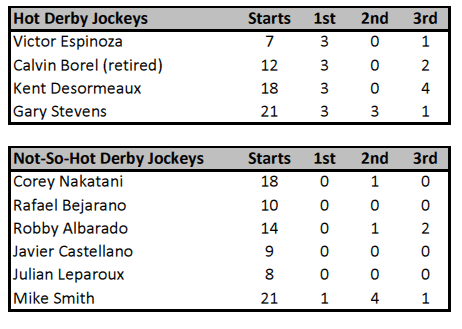 The Kentucky Derby offers some of the best betting value of the year. Given the unique nature of the Kentucky Derby, there are several ways it warrants a different handicapping approach than the other races on the card.
The Kentucky Derby offers some of the best betting value of the year. Given the unique nature of the Kentucky Derby, there are several ways it warrants a different handicapping approach than the other races on the card.
#1 – Pedigree
In my normal course of daily handicapping, I am looking for sires that excel with first time starters or horses trying the turf for the first time, such as Kitten’s Joy, who produces a high percentage of both first-time winners and turf winners. Since a bulk of the daily races are carded as sprints or routes that are a mile and a sixteenth or less, I generally don’t have to consider horses can run ten furlongs. In the event that a normal daily race is carded at a longer distance, it is generally for older horses that will show a couple of efforts at longer distances in their past performances, which eliminates the need for pedigree analysis since they have proven that they can — or cannot — handle the distance.
In the Kentucky Derby, you need to consider what sires produce offspring that can get the distance since all of the horses are trying this distance for the first time. Sligo Bay, Mizzen Mast, and Afleet Alex come to mind when I think of sires that have produced a good share of winners that can handle the grueling ten furlongs.
#2 – Pace
That six-furlong claiming race at your favorite track probably has about seven entrants, of which you can immediately toss one or two horses right away. There may be one solid early speed horse with a pace advantage and you smile all the way to the windows to collect the easy money you just won. The Kentucky Derby is often a different story. There are some years where the pace seems to make sense and falls right into line… and other years where you can expect the unexpected.
Last week, I talked about how Dortmund failed in the 2015 Kentucky Derby despite being a strong early speed horse and how well the race set up for Firing Line and American Pharoah in my article When Strong Early Speed Horses Can Kill You: The 2015 Kentucky Derby Revisited. Yet, I was bewildered by Hard Spun in the 2007 Kentucky Derby.
I had figured he would sit off the pace and be a factor later in that race; however Mario Pino used him up early on the lead and set up Street Sense for the win. In this case, while doing a post-mortem of my race analysis, I should have given some merit to idea that Hard Spun may get used early in an effort to try to clear the field. While he did not have a pace advantage in the race his early run was the kiss of death for my wagers with him on top. You need to consider multiple options when there is no clear cut pace scenario.
#3 – The Importance of Jockeys
Who would you rather drive your car in the Daytona 500 – Richard Petty or Bill the Uber driver that brought you home from the bar last night? Sure, Bill did a good job getting you home safely and in a reasonable time, but he probably can’t handle a stock car. The same thing holds true with jockeys in the Kentucky Derby.
While Robby Albarado has had a great career, amassing upwards of 4,600 victories and is a mainstay in my wagering at the Fair Grounds, he has gone to post in the Derby fourteen times without success other than a second and a pair of third-place finishes. Conversely, Victor Espinoza has been in the irons seven times and has three victories and a third-place finish.

#4 – The Importance of Trainers
Just like with jockeys, who is training the horse matters too. There are plenty of trainers that show yearly win percentages that are very impressive. Todd Pletcher won nearly 24% of his races during 2015 and wins at about 20% in graded stakes races. Yet, he has only managed one Derby winner in 43 starters.
On the other hand, Bob Baffert won 21% of his races in 2015 and wins about 24% of the graded stakes he enters, but has won four Kentucky Derbies in 26 tries. While you can’t totally discount every trainer, those handlers that have shown success need to get a second look. The high-percentage trainers you bet regularly may not correlate to success at this level.
#5 – Form
If you play the same circuit every day, you eventually see the same horses coming back out to run against many of the same foes. Claiming horses don’t earn money by sitting in the barn, so they are typically back out on the track every couple of weeks trying to earn a paycheck. These horses have become creatures of habit and their trainers are not going to try too many new things with them. They will forever run in dirt sprints for various claiming tags and will amass ten to fifteen starts on the year. You can start to see when the horse is doing well, improving or declining in form based on his past performances.
Kentucky Derby entrants will normally show a decent layoff between their juvenile and 3-year-old campaigns, several weeks between starts, and more workouts in preparation for the next prep race they are pointed toward. Their past performances will not likely show the progression of form that the older horses do, making it tougher to assess whether or not that poor last race was a function of bad form or a troubled trip.
The subject of my article Reevaluating the Pace Scenario After Scratches: Part 1 is a great example of how you can see form in the past performances. Rosie My Way started off 2015 in a funk then improved to win on March 15, 2015. She stepped up and regressed a bit, but then rebounded when she shipped down to Pimlico on April. From there she regressed and showed signs of declining form until given a breather for about five months. When she came back, she won three straight, including the race this past performance profile was for on March 15, 2016.

#6 – Post Positions
Normally, you are wrestling with the fact that the horse you like has drawn the outside post in a field that has up to twelve horses. The Kentucky Derby has twenty gates. Everyone is quick to rattle off the fact that the rail post has not won in forever. Personally, I don’t necessarily buy into that completely; there have been some rather lackluster entries to grace the rail in the Kentucky Derby, but I will agree that there are posts that don’t make life easy for you.
If you are breaking from post position 20 and you are a front runner, you have a ton of traffic to clear to get inside and on the lead. Honestly, I like post 14 the best since you have a gap to post 15 which is in an auxiliary gate and perhaps this gives you a little less of a chance of getting knocked around when the gates open. You need to consider the horses that surround your pace horses. Will they be able to get to the lead or are they going to be content to sit back and navigate a maze of tiring foes late in the stretch?
#7 – Class
I handicap every class and condition of race somewhat differently and will discuss that a little further in future articles. A sample of this can be found in my previous article The Devil is in the Details: Finding an Edge in Conditioned Claiming Races. Normally, when I come across a graded stakes race, particularly a Grade I, there are certain factors that I look for:
- Recent races and works are good. If not, are they excusable?
- Recently won a stakes race within half a furlong of today’s distance.
- Trainer that consistently wins Grade I stakes races.
- Horse that has won another Grade I stakes race.
In the Kentucky Derby, you should find horses with good recent races and workouts. You won’t find any horses that have won at today’s distance or within a half of a furlong of today’s distance (typically). The closest you will find are horses that have raced at nine furlongs and are now asked go ten furlongs.
You will find trainers that consistently win graded stakes races, but as I discussed above, the Kentucky Derby is a little different. At this point all of the major preps are graded but not all are Grade I. Some are Grade II, and many of these horses may have also hit some larger ungraded stakes or Grade III stakes along their path to the Kentucky Derby. At this point, there is no real difference between Grade I and Grade II stakes for 3-year-olds since they are restricted to other 3-year-olds and they are all focusing on races that offer Kentucky Derby points.
Realizing that you need to deviate slightly from your normal plan of attack when handicapping the Kentucky Derby will help you to see things a little differently and help you cash some tickets on the first Saturday in May!




